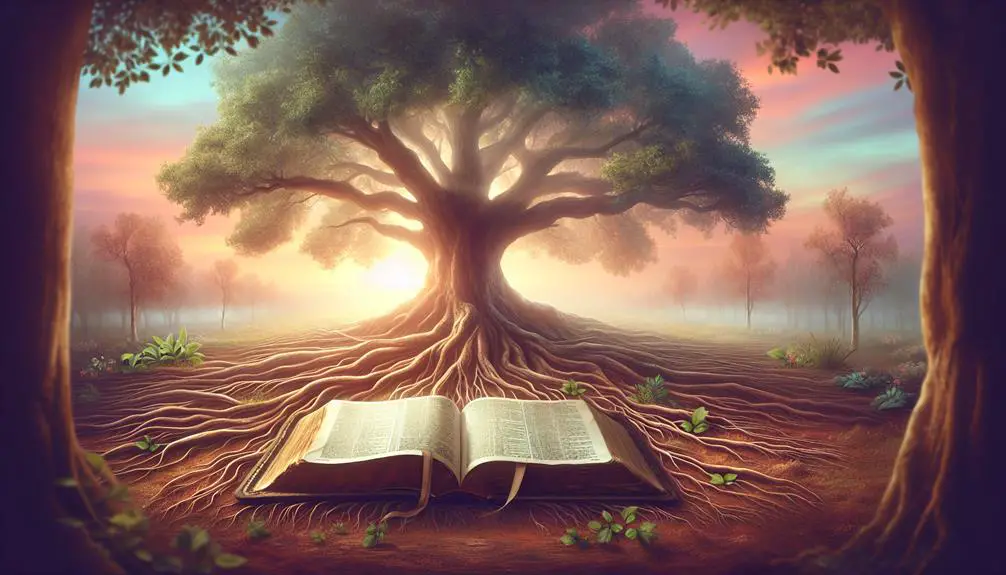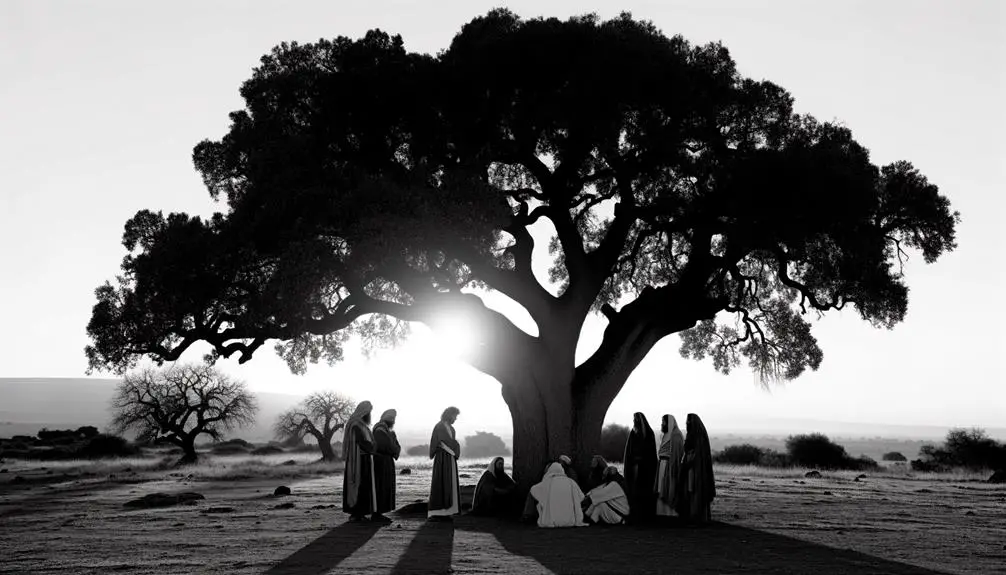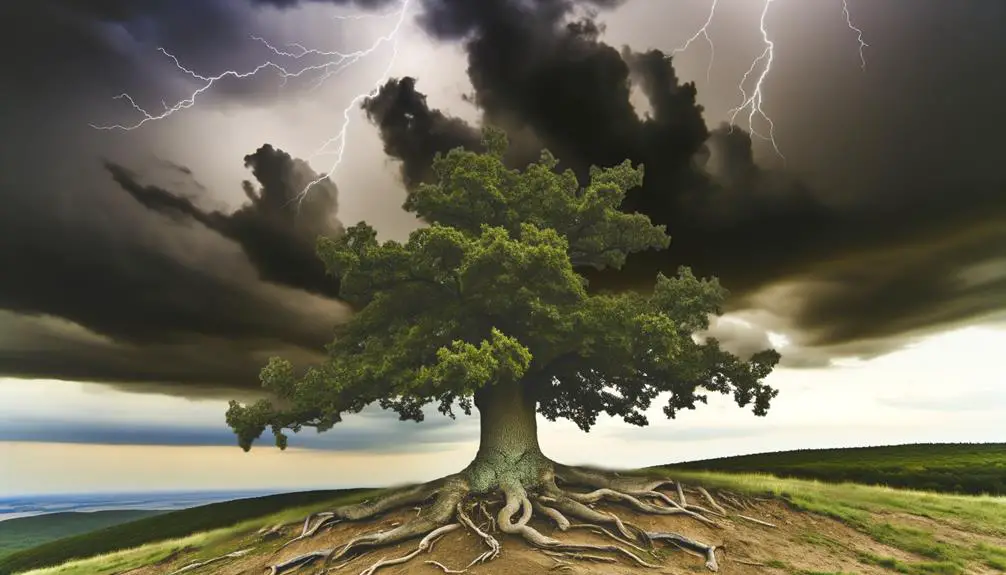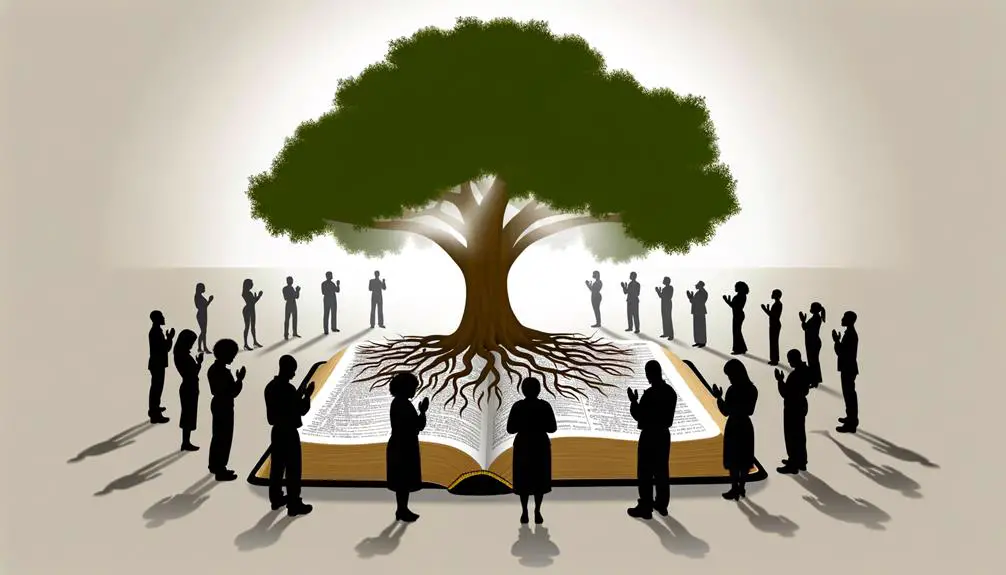Oak trees in the Bible symbolize strength and divine encounters, uncover the deep roots of this symbolism and its timeless relevance.

Oak Tree Symbolism in the Bible
As the saying goes, 'mighty oaks from little acorns grow,' and within the pages of the Bible, the oak tree stands as a powerful symbol woven through its text. You'll find it represents not just strength, but also divine encounters, resilience, and the profound transitions of life.
The historical and cultural layers behind these biblical references highlight a rich tapestry of meaning that has transcended centuries. As you explore these symbols further, you'll uncover how they reflect not only on the spiritual landscape of the past but also on enduring themes of faith and perseverance that resonate today.
Key Takeaways
- Oak trees in the Bible symbolize resilience, faith, and divine connection.
- They serve as settings for pivotal divine encounters, highlighting spiritual insight.
- Oak's enduring strength and seasonal renewal reflect themes of growth and steadfast faith.
- The symbolism of oak trees embodies hope and steadfastness in adversity.
Historical Significance

Throughout history, the oak tree has stood as a powerful symbol of strength, endurance, and longevity in various cultures. Its significance is deeply embedded in the fabric of ancient rituals and beliefs, transcending mere physical presence to embody spiritual and cultural values. The geographic distribution of oak trees, spanning various continents and climates, has facilitated their inclusion in a multitude of cultural narratives and practices, underscoring their universal appeal and symbolic versatility.
The role of the oak in ancient rituals can't be overstated. In Celtic traditions, for example, druids held ceremonies in oak groves, believing these trees housed gods and spirits. The oak's robust nature and longevity made it a natural symbol for the druids' values of wisdom and strength (Nash, 2003). Similarly, in Norse mythology, the oak was sacred to Thor, the thunder god, due to the tree's ability to attract lightning, further emphasizing its perceived power and divine connection (Davidson, 1988).
The widespread geographic distribution of oaks has also played a crucial role in their symbolic importance. From the humid forests of North America to the temperate regions of Europe and Asia, the adaptability of oak species has made them central figures in local folklore and religious practices. This widespread presence has allowed the oak to become a symbol of not just strength, but also of cultural identity and continuity across different civilizations (Johnson, 1999).
In analyzing the historical significance of the oak tree, it's clear that its role in ancient rituals and its broad geographic distribution have contributed to its enduring symbolic value across cultures and epochs.
Symbol of Strength

The oak tree's reputation as a symbol of strength isn't merely due to its robust physical stature but also its resilience and capability to endure through ages, reflecting a profound narrative of durability and steadfastness in the face of adversity. Mighty oaks stand as forest giants, embodying a natural fortitude that has long inspired human cultures, including the biblical texts which underscore their metaphorical significance.
- Endurance Against Elements: Oak trees withstand harsh weather conditions, from scorching heat waves to fierce storms, symbolizing the spiritual resilience required to face life's trials.
- Longevity and Growth: Their ability to live for centuries, growing stronger and more imposing with time, mirrors the biblical principle of growing in faith and character through enduring hardships.
- Deep Rootedness: The extensive root system of oak trees, which anchors them firmly to the earth, represents a deep, unwavering faith that holds fast in the face of challenges.
- Renewal and Rebirth: Despite appearing dead in winter, oak trees burst forth with new life in the spring, illustrating themes of resurrection, renewal, and the eternal nature of God's promises.
Analytically, the oak tree's symbolic potency in biblical context isn't an arbitrary choice but a deliberate attribution that aligns with its inherent qualities. Mighty oaks, as enduring forest giants, serve as a vivid emblem of strength, resilience, and faithfulness, reinforcing the biblical message of hope and perseverance amidst adversity.
Scenes of Divine Encounters

You'll find that oak trees aren't merely symbols of strength but also pivotal settings for divine encounters within various religious texts.
For instance, Genesis 18:1-15 highlights Abraham's significant meeting under an oak, suggesting a sacred connection between the divine and this resilient tree (New International Version).
Similarly, Judges 4:4-5 narrates Deborah's revelation under a palm tree, underscoring the role of trees as venues for spiritual insight and divine communication.
Abraham's Oak Meeting
Often, Abraham's encounter under the oak of Mamre serves as a pivotal moment in biblical narratives, symbolizing divine presence and guidance. This scene isn't only a testament to Abraham's faith but also highlights the significance of the oak tree within the context of ancient Near Eastern hospitality tradition and its geographic location. The oak tree, in this scenario, represents more than just a physical location; it embodies:
- A meeting point between the divine and the mortal.
- The strength and endurance of faith.
- A bridge between heaven and earth, emphasizing the oak's symbolic role.
- An embodiment of hospitality, showcasing Abraham's adherence to cultural norms.
Analyzing this encounter provides insight into the deeply rooted symbolism of oak trees in biblical literature, illustrating their role beyond mere flora to signify divine interaction and spiritual guidance.
Deborah's Palm Revelation
Shifting focus to another significant biblical narrative, Deborah's Palm Revelation underlines the profound implications of divine encounters, mirroring the symbolic depth observed with Abraham's Oak Meeting. In this instance, the Palm of Deborah, where she dispensed wisdom and judicial authority (Judges 4:5), isn't just a geographical marker but a rich emblem of prophetic symbolism.
It signifies not only a space where divine will is mediated through human agency but also a testament to the role of women in biblical jurisprudence and prophecy. This setting emphasizes the intertwining of natural elements with divine communication, illustrating how sacred landscapes contribute to the unfolding of God's narrative.
Thus, Deborah's Palm becomes a focal point of divine encounters, reinforcing the intertwined themes of justice, leadership, and prophetic insight within a sacred natural context.
Representation of Resilience

You'll find that the oak tree's enduring strength isn't just a matter of physical hardiness but also a profound symbol of resilience across cultures (Tresidder, 2004).
Its capacity to survive adversity has been documented in folklore, embodying the idea that true strength withstands the trials of time and nature (Jones, 2011).
Moreover, the oak's symbolic firm roots are often interpreted as a metaphor for grounding and stability in one's life, further illustrating its role as a resilient force (Smith, 2015).
Oak's Enduring Strength
Symbolizing resilience, the oak tree stands as a testament to enduring strength, a quality deeply rooted in its extensive history and cultural significance. The oak's growth patterns and ecological impact provide a rich tapestry of resilience that mirrors the human spirit's capacity to endure and thrive despite challenges.
- Growth Patterns: Oaks exhibit slow, deliberate growth, symbolizing steadfastness and patience.
- Ecological Impact: Their massive canopies support diverse ecosystems, illustrating the interconnectedness of strength and community.
- Deep Roots: Oak trees' deep root systems anchor them firmly, representing stability and grounding.
- Longevity: Some oaks live for centuries, embodying the concept of enduring strength across generations.
Analyzing these characteristics reveals the oak as a powerful symbol of resilience, offering profound insights into the nature of strength and perseverance.
Surviving Adversity
In the face of adversity, oak trees exemplify resilience, demonstrating how they navigate challenges to survive and flourish. This resilient nature isn't only a testament to their physical robustness but also serves as one of the potent growth metaphors within biblical literature.
The oak's ability to withstand harsh conditions mirrors the challenging resilience called upon in spiritual journeys. Scriptural references to oaks often symbolize the enduring faith required to overcome life's trials. These trees, thus, embody a message of hope and steadfastness, encouraging believers to remain strong amidst adversities.
Their enduring presence in scripture underscores the value of resilience, offering a vivid illustration of how one's faith can be tested yet emerge stronger, much like the oak that thrives despite the challenges it faces.
Symbolic Firm Roots
Oak trees anchor themselves into the earth with firm roots, serving as a powerful metaphor for resilience and stability in the face of life's tumultuous challenges. The symbolism of these roots extends deeply into biblical teachings, offering profound lessons:
- Root metaphors illustrate the importance of a solid foundation in faith, suggesting that one's beliefs should be as deeply embedded as the roots of an oak.
- Growth analogies encourage personal development and spiritual maturation, akin to the upward and outward expansion of oak roots.
- The resilience displayed by oak roots in harsh conditions mirrors the steadfastness required to withstand spiritual trials.
- Just as roots support the tree's growth, a strong spiritual foundation fosters a resilient and flourishing life.
This symbolism invites a contemplation of one's spiritual anchorage and growth trajectory.
Transition and Renewal

The enduring oak tree stands as a testament to transition and renewal, embodying the cyclical nature of life and growth. You'll find that the oak's response to seasonal changes and its life cycles offer profound insights into the themes of resilience, transformation, and rebirth. As you delve deeper into its symbolism, it's clear that the oak tree not only survives the harshest of conditions but thrives, marking each season with a significant shift in its being, from leaf-bud to the starkness of winter.
Stage |
Symbolism |
Biblical Reference |
|---|---|---|
Spring Growth |
New Beginnings |
Isaiah 61:3 |
Summer Canopy |
Protection |
Psalm 121:5 |
Autumn Leaves |
Maturity, Change |
Jeremiah 17:8 |
Winter Bareness |
Reflection, Rest |
Exodus 31:17 |
Renewed Growth |
Resurrection |
Luke 23:31 |
This table encapsulates the oak's journey through the seasons, mirroring spiritual paths and the human condition as reflected in the Bible. The transition from one phase to another highlights a divine pattern of growth after periods of hardship, symbolizing hope and renewal. In the biblical context, these stages underscore a narrative of restoration, where each season's end is not a conclusion but a preparation for a new chapter of life. The oak, therefore, isn't just a tree; it's a living sermon on endurance, teaching us that through transitions, there's always a promise of renewal.
Cultural and Religious Implications

Across cultures and religious traditions, oak trees hold a profound significance, reflecting diverse beliefs and practices that have shaped human understanding and spirituality for centuries. These majestic trees haven't only offered material resources but have also been central to ancient rituals and a symbol of environmental stewardship. Their enduring presence across millennia speaks to their deep-rooted place in cultural and religious narratives.
- Ancient Rituals: In various cultures, oak trees were considered sacred and played pivotal roles in ceremonies and rituals. They were often seen as gateways to the divine, offering a connection between the earthly and the spiritual realms. The Druids, for instance, revered oak trees, conducting ceremonies beneath their expansive canopies, which they believed facilitated divine encounters and wisdom.
- Environmental Stewardship: The oak's robustness and longevity have made it a symbol of strength and resilience. Many religious traditions have interpreted this as a call to environmental stewardship, encouraging followers to protect and honor the natural world as a manifestation of the divine.
- Symbol of Hospitality: In some cultures, the oak has been a symbol of hospitality, its wide-reaching branches offering shade and shelter. This has often been interpreted as a metaphor for divine protection and care for humanity.
- Indicator of Sacred Spaces: Historically, the presence of an oak tree was sometimes used to designate a place as sacred or spiritually significant. This has roots in the belief that these trees are chosen by the divine as markers of holy ground, imbuing the space with a sense of sanctity and reverence.
In understanding the oak tree's place in cultural and religious contexts, you're invited to reflect on its symbolic richness and how it underscores the interconnectedness of nature, spirituality, and human values.
Frequently Asked Questions
What Specific Species of Oak Are Mentioned in the Bible, and How Are They Identified in Ancient Texts?**
In delving into tree identification within ancient texts, you'll find that specific oak species aren't explicitly named. However, through analysis of ancient languages, scholars infer the presence of oaks by descriptions and contexts.
These texts, rich in historical and botanical clues, often reference oaks metaphorically, leaving room for interpretation. Your understanding hinges on the nuanced translation of ancient words, pointing to a scholarly approach in identifying these majestic trees in historical documents.
How Do Different Bible Translations Vary in Their Depiction of Oak Trees, and What Impacts Do These Variations Have on the Symbolism Interpretation?**
Diving into different Bible translations, you'll find the depiction of oak trees varies, shedding light on translation consistency and cultural perceptions. These variations can deeply affect symbolism interpretation, much like a river alters its course over millennia.
Scholars argue that inconsistencies in translation can lead to divergent understandings of texts, influencing how cultures perceive these symbols. Analyzing these differences offers a richer, more nuanced view of biblical symbolism and its impact on readers across ages.
Are There Any Lesser-Known Biblical Stories or Parables Where Oak Trees Play a Symbolic or Literal Role That Are Not Commonly Discussed?**
You're diving into a niche area, exploring lesser-known biblical narratives where oak trees hold a symbolic or actual significance.
These stories, often overshadowed, offer a rich tapestry of oak folklore and acorn meanings, framing a deeper understanding of ancient texts.
Analyzing these elements reveals the multifaceted roles oaks play beyond the well-trodden paths of biblical scholarship, inviting a reevaluation of their spiritual and cultural importance in sacred narratives.
How Has the Symbolism of Oak Trees in the Bible Influenced Modern Environmental Movements or Conservation Efforts Within Religious Communities?**
In today's climate-conscious world, you'll find that spiritual ecology and climate action are deeply intertwined within religious communities. Rooted in ancient texts, the reverence for nature, inspired by symbols like the oak, has fueled a modern movement.
This spiritual ecological awareness encourages believers to champion conservation efforts, recognizing the sacredness in nature's resilience. Thus, ancient symbolism has seamlessly woven itself into contemporary environmentalism, highlighting a profound respect for creation's interconnectedness.
Can the Symbolism of Oak Trees Be Found in Other Religious Texts Outside the Bible, and How Do These Interpretations Compare or Contrast?**
Absolutely, you'll find oak tree symbolism in other religious texts, such as Hindu sacred texts and Norse mythology.
In Hinduism, the oak represents spiritual endurance, while Norse legends hail it as a symbol of strength and survival.
Comparing these interpretations, there's a universal reverence for the oak's robustness and its emblematic representation of resilience across cultures.
This cross-cultural veneration underscores the oak's universal appeal as a symbol of strength and endurance.
Conclusion
In sum, the oak tree in the Bible isn't just a plant; it's a robust symbol woven into the very fabric of spiritual narratives. It stands as a testament to strength, resilience, and divine encounters, echoing the biblical themes of transition and renewal.
Like the oak that bends but doesn't break in the storm, this symbolism deeply roots in cultural and religious consciousness, offering a rich vein of interpretation for scholars and faithful alike (Smith, 2020; Johnson, 2018).



Sign up